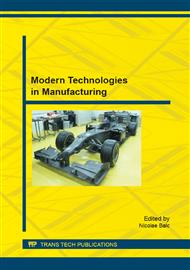[1]
G. M. Krolczyk, P. Nieslony, J. B. Krolczyk, I. Samardzic, S. Legutko, S. Hloch, S. Barrans, R. W. Maruda, Influence of argon pollution on the weld surface morphology, Measurement. 70 (2015) 203-213.
DOI: 10.1016/j.measurement.2015.04.001
Google Scholar
[2]
G. Krolczyk, S. Legutko, Investigations Into Surface Integrity in the Turning Process of Duplex Stainless Steel, Transactions of FAMENA. 38(2) (2014) 77-82.
Google Scholar
[3]
S. Wojciechowski, T. Chwalczuk, P. Twardowski, G.M. Krolczyk, Modeling of cutter displacements during ball end milling of inclined surfaces, Archives of Civil and Mechanical Engineering. DOI: 10. 1016/j. acme. 2015. 06. 008.
DOI: 10.1016/j.acme.2015.06.008
Google Scholar
[4]
P. Hreha, A. Radvanska, L. Knapcikova, G.M. Królczyk, S. Legutko, J.B. Królczyk, S. Hloch, P. Monka, Roughness parameters calculation by means of on-line vibration monitoring emerging from AWJ interaction with material, Metrology and Measurement Systems. 22. 2 (2015).
DOI: 10.1515/mms-2015-0024
Google Scholar
[5]
J.B. Krolczyk, The use of cluster analysis method to describe the mixing process of the multi-element granular mixture, Transactions of FAMENA. XXXVII (4) (2014) 43-54.
Google Scholar
[6]
J.B. Królczyk, A. Rezwiakow, M. Tukiendorf, Mixing of biomass and coal in a static mixer as an example of technological solutions involving implementation of renewable energy sources, Ecol CHEM ENG S. 4 vol. 21 (2014) 685-696.
DOI: 10.1515/eces-2014-0050
Google Scholar
[7]
V. Sharma, S. Chattopadhyaya, S. Hloch, Multi response optimization of process parameters based on Taguchi-Fuzzy model for coal cutting by water jet technology, International Journal of Advanced Manufacturing Technology. 56, 9-12 (2011) 1019-1025.
DOI: 10.1007/s00170-011-3258-x
Google Scholar
[8]
P. Bere, P. Berce, O. Nemes, O., Phenomenological fracture model for biaxial fibre reinforced composites, Composites Part B: Engineering. 43(5) (2012) 2237-2243.
DOI: 10.1016/j.compositesb.2012.01.073
Google Scholar
[9]
H. Iancau, P. Bere, M. Borzan, L. Hancu, A. Crai, The Influence of Reinforced Materials and Manufacturing Procedures on the Mechanical Characteristics of Polymeric Composite Materials, Revista Materiale Plastice. 45(3) (2008) 251-256.
Google Scholar
[10]
D. Kinik, B. Gánovská, S. Hloch, P. Monka, K. Monková, Z. Hutyrová, On-line monitoring of technological process of material abrasive water jet cutting, Tehnički vjesnik. 22(2) (2015) 351-357.
DOI: 10.17559/tv-20130904111939
Google Scholar
[11]
A. Radvanská, J. Petrů, K. Monková, T. Zlámal, P. Hreha, M. Šomšák, A. Andrej, B. Šafran, Rationalization of manufacturing of plastic injection moulds by abrasive waterjet, Tehnički vjesnik. 22(2) (2015) 521-525.
DOI: 10.17559/tv-20130502125348
Google Scholar
[12]
M. O. Senvar, O. Vayvay, E. Kurt, S. Hloch, Prioritization of balanced scorecard measurement indicators as a process management approach via fuzzy AHP: case study in automotive industry, Tehnički vjesnik. 21(1) (2014) 155-162.
Google Scholar
[13]
A.S. Tasu, Programmable logic controller, Romanian Journal of Physics. 51(1/2) (2006) 305.
Google Scholar
[14]
W. Bolton, Programmable logic controllers, fourth ed., Newnes, (2015).
Google Scholar
[15]
G. Dunning, Introduction to programmable logic controllers, third ed., Cengage Learning, (2005).
Google Scholar
[16]
A. Glowacz, Diagnostics of DC and Induction Motors Based on the Analysis of Acoustic Signals, Measurement Science Review. 14(5) (2014) 257-262.
DOI: 10.2478/msr-2014-0035
Google Scholar
[17]
A. Glowacz, Recognition of Acoustic Signals of Loaded Synchronous Motor Using FFT, MSAF-5 and LSVM, Archives of Acoustics. 40(2) (2015) 197-203.
DOI: 10.1515/aoa-2015-0022
Google Scholar
[18]
A. Glowacz, Diagnostics of direct current machine based on analysis of acoustic signals with the use of symlet wavelet transform and modified classifier based on words, Eksploatacja i Niezawodnosc – Maintenance and Reliability. 16(4) 2014 554-558.
Google Scholar
[19]
A. Glowacz, Diagnostics of synchronous motor based on analysis of acoustic signals with the use of line spectral frequencies and K-nearest neighbour classifier. Archives of Acoustics. 39(2) (2014) 189-194.
DOI: 10.2478/aoa-2014-0022
Google Scholar
[20]
Z. Wu, R. Sekar, Study of factors impacting remote diagnosis performance on a PLC based automated system, Journal of Manufacturing Systems. 33(4) (2014) 589-603.
DOI: 10.1016/j.jmsy.2014.05.007
Google Scholar
[21]
K. Kamiński, Programing in Step7 MicroWin (in Polish), third ed., GRYF, (2006).
Google Scholar


